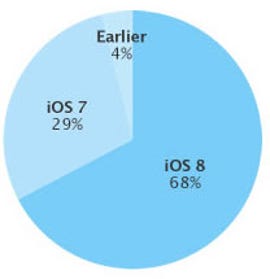
Apple
Apple’s iOS is now at home on nearly 70 percent of all iOS devices.
Releasing the latest figures on its App Store Distribution page on Tuesday, Apple estimated iOS 8’s share at 68 percent, followed by iOS 7 at 29 percent and older versions collectively at 4 percent. The new stats show the percentage of iOS devices recorded at the App Store on Monday.
The latest share for iOS 8 shows continued growth from 64 percent on December 22, 56 percent on November 12, 52 percent on October 29 and 47 percent on October 5.
Numbers from mobile analytics firm Mixpanel show a similar uptake in iOS 8 with a 69.1 percent share as of Wednesday. Fellow analytics provider Fiksu shows a 64.9 percent share as of Monday.
Apple measures devices that upgrade to iOS 8 (currently iOS 8.1.2
) as well as new devices that already come installed with the latest verson of the mobile operating system. So the January gain in iOS 8 adoption is likely due in part to consumers who received an iPhone or iPad for the holidays. But it also may be a sign that more people are willing to download the new version.


Apple
iOS 8’s effort to reach loyal users has been a steady but slow one. Adoption has lagged behind that of iOS 7 over the same period last year, likely due to a bumpy liftoff for the new version.
Released September 17, iOS 8 came with a number of technical issues, prompting Apple to roll out iOS 8.0.1 as a fix a week later. But version 8.0.1 was saddled with more bugs, such as an inability to connect to cellular networks or use the Touch ID fingerprint sensor.
Apple quickly removed 8.0.1 from distribution and deployed iOS 8.0.2 on September 25. Apple continued to update its latest mobile OS with iOS 8.1 on October 20 and iOS 8.1.2 on December 19. Still, a few bugs remain, according to MacRumors, including one that causes Messages conversations to take a long time to open. As such, Apple has already cooked up iOS 8.2 and seeded the third beta of that version to developers.
(Via iPhone Informer)




